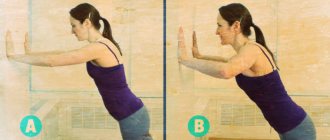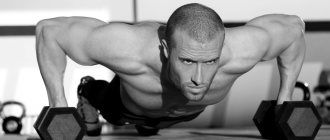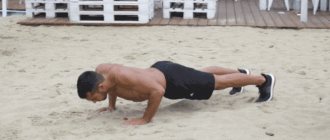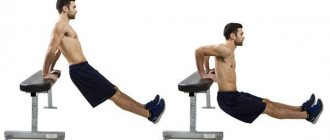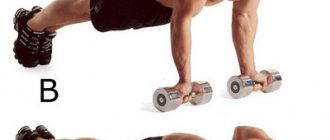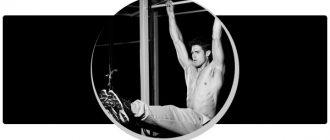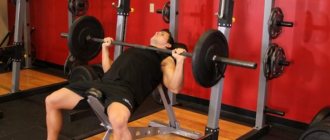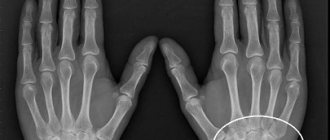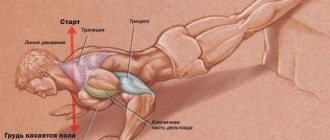There are many types of push-ups, and all of them are beneficial as they affect our body in different ways. Today we will talk about Indian push-ups, also known as bomber push-ups or bomber push-ups. Their peculiarity is that the load is emphasized on the anterior deltoid muscles; in addition, the spinal extensor muscles receive secondary load. And so how to do Indian push-ups.
Benefits of exercise
Indian push-ups, proven over centuries, when performed regularly, will allow you to experience a number of positive effects:
- Strengthening the muscles of the shoulders, arms and chest. Development of muscle strength and endurance.
- Improving spinal flexibility, training the back and core muscles.
- Changing the position of the body from the usual to an inverted one stimulates the functioning of the circulatory system, improves the condition of the vessels of the head and prevents congestion in the pelvis.
- Stretching the pectoral muscles and abs in the second phase of the exercise allows you to increase the work performed by these muscles, and therefore increase the effectiveness of the training.
Contraindications to performing the exercise are high blood pressure, headache, vascular diseases of the head, injuries to the shoulder joints, and in women - menstruation.
Push-ups in sports and cinema[edit | edit code]
Some modern athletes believe that they owe their phenomenal strength and success to the humble push-up. For example, National Football League great Herschel Walker never lifted weights and stated that push-ups were his only muscle-building exercise. Walker won the Heisman Trophy and amassed more than 13,000 yards during his career in two professional college football leagues. In a 2006 phone interview, Walker said he still does 2,500 crunches and 1,500 push-ups every morning, a routine he's followed since high school. Boston Red Sox outfielder Ted Williams performed 50 to 100 fingertip push-ups every day.
The ancient Kushti wrestling was considered a royal sport in India. Pahlwan wrestlers rose at 5:30 a.m. every day to perform several thousand Indian push-ups and squats in one workout, which made them incredibly strong and resilient. The Great Gama, who went down in history as the most successful pahlavan of all time, performed at least 2 thousand push-ups in the Indian style in one workout. To this day, he remains the only wrestler who did not lose a single bout in his entire career, which lasted more than 50 years.
Push-ups are one of the main exercises for boxers around the world. Legendary heavyweights such as Rocky Marciano, Muhammad Ali and George Foreman all performed hundreds of push-ups. Chinese kung fu genius Bruce Lee, who paid particular attention to his arms and chest, credited his upper body strength largely to countless push-ups. Among other things, Bruce Lee was the first to demonstrate the ability to perform push-ups using the thumbs and index fingers at the 1960 International Karate Championships in Palm Beach.
Bodybuilders also recognize the benefits of push-ups. On several occasions, 1970s champion Bill Pettis, famous for his 23-inch biceps, conducted workouts that consisted of more than 3,000 push-ups. Such training lasted at least 5 hours. George Eiferman, a classic 1940s bodybuilder with phenomenal chest dimensions, went down in history by performing push-ups while training with his hands resting on benches to maximize the amplitude of lowering his body. It's no coincidence that his impressive chest would put many of today's bodybuilders to shame.
It is known that in Hollywood, push-ups are also used to create enviable physical characteristics. Before starring in the film G.I. Jane, actress Demi Moore underwent a grueling physical training program that included steeplechase running, cross-country running, swimming and, of course, hundreds of push-ups. Perhaps the main thing that Demi Moore is remembered for in the mentioned film is her one-arm push-ups.
Actor Clint Eastwood did intense workouts every day. It is said that at the peak of his career he performed a thousand push-ups a day.
Load distribution
In general, the load during the exercise is distributed in a similar way to regular push-ups. The main work is performed by the triceps, pectoralis major muscles and, unlike traditional push-ups, this exercise forces the anterior deltoid muscles to actively work.
Additionally, spinal extensors, abs, and small core muscles are involved. In other words, the load map is quite extensive and you can safely include this exercise in your upper body training program.
Execution technique
The exercise can be roughly divided into two phases, when you move forward and go back. Let's look at them in detail.
Starting position: take a lying position, placing your palms slightly wider than your shoulders. Then move your feet closer to your hands so that your pelvis rises up. The pelvis must be raised so that the arms are in line with the body and neck. At the same time, the lower back is slightly arched, the legs remain as straight as possible. If you do yoga, it's simple: get into downward-facing dog pose. Initial position
Performing push-ups:
- Raise your head so you can look ahead. Bend your elbows and lower your chest almost to the floor, arching your back. Try not to bend your legs. It's like you're ducking under an obstacle. At the same time, the body moves forward.
- Once past the bottom point, push yourself up and forward, fully extending your arms. At the same time, the pelvis goes down, the back is arched as much as possible. Yogis take an upward-facing dog pose, with only their feet resting on their toes.
- Now you need to perform the entire movement in reverse order and return to the starting position. Push your pelvis back and bend your arms. We move our chest above the floor, extend our arms and lift our pelvis.
- Repeat the movement the required number of times.
During the exercise, your chest moves in an arc. The movement is done smoothly without jerking. First you need to do several bends, waves and twists, thus stretching your back and stretching your spine. You can use it on triceps and chest days.
Execution technique.
Indian push-ups can also be performed as a morning exercise. Exercise perfectly invigorates, accelerates metabolism and tones the cardiovascular system.
Regularly performing Hindu push-ups will significantly strengthen your arms, chest and shoulders, as well as your back and abdominal muscles.
Today the fitness industry is experiencing its second boom. The first occurred in the 60s of the last century. Many women and men around the world have decided to get involved in weight lifting through powerlifting, fitness or bodybuilding. Each athlete is individual, so new exercises borrowed from other sports appear in the industry. One of these exercises was Indian push-ups.
Exercise “Cross push-ups”
The right hand is on the floor, the left hand is located on the disc from the barbell. Get down. Push up from the floor with a sharp, explosive movement. Try to point your body up and to the left. You need to land now with your right hand on the disc. Repeat the movement in the opposite direction. Congratulations! Replay done! Place your palms slightly wider than your shoulders.
Some secrets of execution: the explosive push-up mode requires much more energy compared to the regular push-up method. You push off the floor with force - more muscle fibers are involved. Consequently, there is a large loss of calories. And the result is steel muscles instead of fat deposits.
The key word is a balanced body!
Benefit
Indian push-ups come from Eastern medicine and are a general strengthening exercise. However, their mechanics can hardly be equated to basic movements. From the point of view of benefits for the athlete, this complex is capable of:
- Significantly increase testosterone production in the body;
- Neutralize the main catabolic processes;
- Strengthen ligaments thanks to a very specific load;
- Replace the main basic complexes in the absence of sports equipment.
Well, the most important advantage of Indian push-ups is their high efficiency. Thanks to the non-standard angle of working the pectoral muscles, you can shock them and overcome a strength plateau, which is important for athletes who have difficulty further increasing their athletic performance. Another important feature of this eastern exercise is the extensive involvement of the spinal muscles. This is especially useful for those who lead a sedentary lifestyle and do not yet strive to go to the gym, but want to prevent osteochondrosis, osteoporosis and other vertebral diseases.
Contraindications and harm
Unlike the axial loads that occur during lower and upper back exercises, Indian push-ups are memorable for their ability to help recover from injury. And most importantly, they do not have any specific contraindications, except:
- The presence of severe muscular dystrophy;
- The presence of a prolapsed hernia;
- Kyphotic curvature of the spine;
- Diseases associated with the gastrointestinal tract;
- Postoperative periods when working with the abdominal muscles;
- Hypertension.
The only harm these push-ups can do is increase the pressure. And then, this is only possible if you seriously disturb your breathing technique during the exercise.
What muscles work?
During Indian push-ups, significantly more different muscle groups are involved than with classical push-ups. However, the load on them is distributed more evenly, which somewhat reduces the effectiveness of this exercise as a basic one.
| Muscle group | Load type | Accent |
| Breasts | Main active | Significant |
| Pectoral bundles | Additional active | Small |
| Triceps extensor | Main active | Significant |
| Psoas muscles | Additional active | Small |
| Core muscles | Additional active | Small |
| Abdominal muscles | Main active | Significant |
| Front delts | Main active | Significant |
| Upper deltas | Main active | Significant |
| Rear delts | Additional active | Absent |
| Biceps flexor arm | stabilizing | Absent |
| Forearm muscles | Main active | Significant |
| Psoas muscles | Stabilizing | Absent |
| Trapezoidal | Stabilizing | Absent |
| Quadriceps | Main active | Significant |
| Calf | Main active | Significant |
Exercise “Dumbbell push-ups”
Place 2 dumbbells in front of you. Stand on them with your hands, turn your hands with your palms away from you. The middle of the chest is equal to the dumbbell line.
Lower yourself down, lightly touch the dumbbells with your chest and rise up again. Be sure to make sure that your elbows do not diverge to the sides.
Some secrets of execution: the elbows should be pressed tightly to the body. If you take into account regular push-ups, they mainly involve the muscles of the delta, chest, and triceps. And when you turn your palms forward, the biceps take a considerable part of the load on themselves, which significantly increases the effectiveness of the exercise.
The key word is degreasing!
Features of the technology
The main feature of Indian push-ups is a very specific technique for performing the exercise. For many athletes, it will seem very distorted and incorrect. But let's take a closer look.
- First you need to stand upright while lying down;
- After taking the position, place your hands slightly narrower than shoulder width (something between a grasshopper and classic push-ups);
- Next you need to do a reverse bend in your back. Those. raise the gluteal region while maintaining a general deflection in the lower back;
- At the moment you begin to bend your arms, you need to move the body, pressing the buttocks, and shifting the body slightly forward in relation to the arms;
- In the lower phase of the movement you need to linger a little (for 1-2 seconds);
- Next, when exiting the push-up, you need to increase the arch in your back, imitating the “cat” movement.
Breathing deserves special mention. An important feature of the exercise is the fact that it is highly not recommended to use a full breath when performing it. Everything is done on a half-inhalation with tension in the diaphragm muscles to hold the air. Exhale when exiting the push-up. This exercise should be performed at a moderate pace.
Benefits of exercise
These push-ups are an example of a classic multi-joint exercise.
The more joints and muscle groups involved during a workout, the more effective it will be. Hindu push-ups, due to the specifics of their implementation, have additional positive effects:
- changing body position makes the spinal column more flexible and also stimulates the functioning of the cardiovascular system;
- specific load helps strengthen ligaments;
- performing Hindu on a regular basis increases the strength and endurance of the pectoral muscles, back, abs, legs and arms;
- Indian bench press increases the production of the hormone testosterone, thereby enhancing the effectiveness of training and neutralizing catabolic processes.
Exercise “Push-ups on medicine balls”
Place three to five medicine balls in a semicircle near you. The more medicine balls, the more difficult the exercise. Your task: gradually walk the entire semicircle from left to right. On one ball, both hands - push-ups. Then the right hand goes to the next ball. The left hand remains in place - push-ups again.
The left hand joins the right hand - again a push-up. And so on until all the balls are used in turn. Then you go back in the same way - this is one repetition! Difficult? But it’s effective!
Some secrets of execution: the palms are directly under the shoulders. The muscles of the abdomen and thighs are weaker, therefore, with such weak muscles, ordinary push-ups may well cause a lower back injury. You need it? Of course not! Therefore, the exercise “Push-ups on medicine balls” strengthens the stabilizer muscles by 20%.
The key word is chest emphasis!
Correct technique
The technique of performing the Indian press may seem distorted, but it allows you to place more emphasis on strength indicators.
Important!
Watch your breathing while doing the exercise. Inhale when moving forward and arching your back, and exhale when you return to the starting position, before a new approach. The exercise is performed as follows:
- Starting position: lying down, arms slightly wider than shoulders.
- Lift your pelvis up, forming a reverse arch in your back. For those familiar with yoga, get into Downward-Facing Dog pose. Raise your head, bend your elbows and lower your chest as low as possible to the floor. Move your body forward, arching your back, as if ducking under an obstacle. Try not to bend your legs.
- From the bottom point, push up, fully extending your arms. Create a maximum arch in your back, stretch your pelvis towards the floor. Get into Upward-Facing Dog pose.
- After this, bend your elbows and push your pelvis back. Walk your chest low to the floor, straighten your arms and push your buttocks up.
Video: Hindu push-up technique
Try to make movements smoothly, without rushing. Avoid jerking. Choose the optimal number of approaches for yourself.
- Take the position usual for push-ups while lying down.
- Place your arms slightly wider than shoulder-width apart.
- The legs remain straight and the buttocks are raised up, as if arching the back on all fours.
- Bend your arms and lower your body down in a rounded arc.
- When your hips are down, straighten your arms and arch up.
- Your hips should almost touch the floor, your arms straight, and your back arched.
- Return to the starting position by lifting your buttocks up and straightening your arms.
Exercise “Push-ups with a stop”
The usual starting position for push-ups. Go down halfway - pause. Go even lower - another pause. Return to the halfway position. Another pause. Return to the starting position. Take a final pause. You did one rep! Pauses in this exercise play a very significant role!
Some secrets of execution: the chest goes down first, and only then the pelvis. The neck should be in line with the back. Even with the best workout, there are still areas that are not used. For regular push-up exercises, this is the top third, middle or bottom third of the amplitude. The pauses you make in the exercises increase the strength of the load not only by a third of the amplitude, but also by 10 degrees to the right and left. Due to this, muscle growth is stimulated. Therefore, performing the exercise without pauses is not effective!
The key word is strong shoulders!
Push-ups (Indian press): description of the exercise
- Push-ups are a necessary element of training not only for beginner athletes, but also for professionals. With the help of high-quality push-ups, you can achieve a pumped up torso, abs and, of course, arms. Different types of push-ups will allow you to choose the load of the desired degree of severity.
One of the unusual varieties of push-ups is the “ Indian press
" This exercise is not easy, but it is very effective for developing the muscles of the chest, shoulder girdle, as well as strengthening the legs and back, improving blood circulation and increasing flexibility throughout the body. Pay attention to your breathing when performing this exercise - as you exhale, you assume a lying position, while inhaling, you move forward and bend, the starting position is taken as you exhale, and inhale before the next repetition of the exercise.
| Exercise | Projectile | Muscle group | Muscles involved | Popularity | Rating |
| Push-ups (narrow hand placement) | Using body weight | Breast | Pectoral muscles | 336982 | 3761 |
| Push-ups (wide arms) | Using body weight | Breast | Pectoral muscles | 202551 | 1041 |
| Push ups | Using body weight | Breast | Pectoral muscles | 201175 | 1201 |
| Bench press | Barbell | Breast | Pectoral muscles | 177409 | 815 |
| Lateral raises with dumbbells | Dumbbells | Breast | Pectoral muscles | 168525 | 1397 |
There are many types of push-ups
, and all of them are beneficial as they affect our body differently. Today we will talk about Indian push-ups, also known as bomber push-ups or bomber push-ups. Their peculiarity is that the load is emphasized on the anterior deltoid muscles; in addition, the spinal extensor muscles receive secondary load. And so how to do Indian push-ups.
Correspondence
The exercise is suitable for:
- Dynamic stretching - stretch and warm the muscles of the complex
- strength endurance - the muscle undergoes load during movement and thus obtains smooth exhaustion, negative phases of some muscles appear active for others. This caused an active release of synergists. The more serious you are, the more difficult it will be to perform the movements.
- increasing stability and coordination of the trunk muscles. Improves exercise performance: Grani bar/dumbbell bench press/poluleg/leg kickback, dumbbell shoulder press, military press
It is suitable for inclusion in programs with circuit fitness nutrition, as a second nature, or exercise programs for the chest and shoulders.
Hindu push-ups, dandas, or as they are also called Indian presses, are a unique exercise that develops not only strength in the upper body, but also helps improve the flexibility of the spine. It is believed that the movement in its current form was borrowed from the training arsenal of Indian wrestlers. People who are interested in yoga will clearly perceive in it a similarity to the pose of a dog, which first looks down and then up.
Execution technique
Before you begin, warm up well, especially paying attention to your spine. The first thing you need to do to perform Indian push-ups
is to take the standard position for most push-ups while lying down, with your hands positioned slightly wider than your shoulders. Then pull your feet towards your palms until your pelvis is raised, as shown in the figure, while your legs and back should not bend. This is the starting position. Start lowering your torso, pushing it forward as if you are overcoming an invisible obstacle. When your hips drop, use your arms to push your torso up. At the end, lower your torso while raising your hips - this is one repetition. If it is difficult to perform this type of push-up, place your hands on a small hill.
What are the benefits of Indian push-ups?
Indian push-ups work the same muscles as regular push-ups: pectoral, triceps and anterior deltoids.
Only the anterior deltoid muscle takes on more load; if you want to strengthen its strength, then Indian push-ups are good for you. This exercise is different from other types of push-ups
, actively engages the muscles responsible for changing the position of the spine - the core muscles
(spinal extensors and abs)
, allowing you to increase not only their strength but also flexibility. In addition, due to this change in body position during repetition, Indian push-ups also have a good effect on the vascular system, due to a dynamic change in pressure in it.+
To the question of when and how much to do. I would include Indian push-ups in chest and triceps training after the main exercise in 4-6 sets, the number of repetitions here is individual, in order to add load to the front deltoids and work the core muscles a little. Indian push-ups are also good for exercise, helping to wake up due to the active work of the vascular system.
Hindu or Indian push-ups - strengthening the upper body
The material was prepared by the site team with the support of our experts: athletes, coaches and nutrition specialists. Our team >>
- Reading time: 3 min.
- Benefits of exercise
- Load distribution
- Execution technique
Hindu push-ups, dandas, or as they are also called the Indian press, are a unique exercise that develops not only the strength and endurance of the muscles of the upper body, but also helps improve the flexibility of the spine. It is believed that the movement in its current form was borrowed from the training arsenal of Indian wrestlers. People who are interested in yoga will clearly perceive in it a similarity to the pose of a dog, which first looks down and then up.

